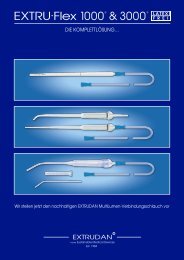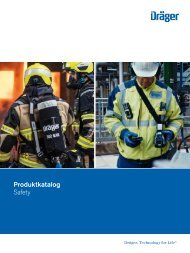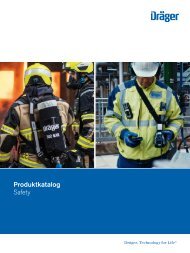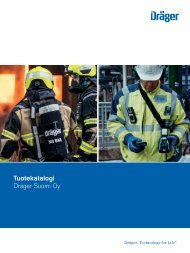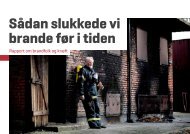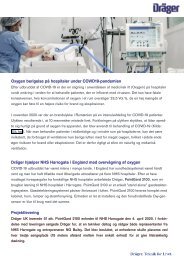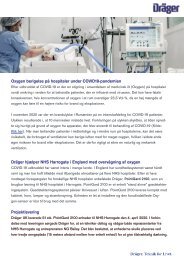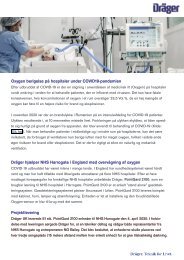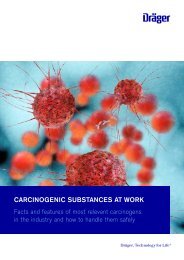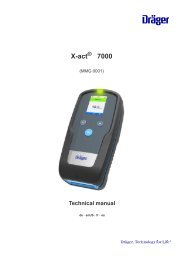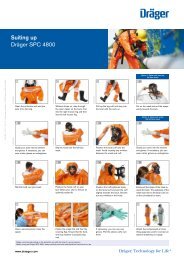Neonatal-Non-Invasive-Ventilation-NIV
Neonatal intensive care continues to be one of the most challenging fields in medicine. Fortunately years of experience from careful clinical observation, meticulous research and plenty of tender loving care have helped to significantly increase the chances of survival for our tiny patients. This booklet is an attempt to address the current development process of noninvasive ventilation therapies, both from a theoretical and a practical standpoint.
Neonatal intensive care continues to be one of the most challenging fields in medicine. Fortunately years of experience from careful clinical observation, meticulous research and plenty of tender loving care have helped to significantly increase the chances of survival for our tiny patients. This booklet is an attempt to address the current development process of noninvasive ventilation therapies, both from a theoretical and a practical standpoint.
You also want an ePaper? Increase the reach of your titles
YUMPU automatically turns print PDFs into web optimized ePapers that Google loves.
36 I 4. LITERATURE<br />
52. Manley BJ, Owen LS, Doyle LW, Andersen CC, Cartwright DW, Pritchard MA,<br />
Donath SM, Davis PG. High-flow nasal cannulae in very preterm infants after<br />
extubation. N Engl J Med. 2013; 369: 1425-33.<br />
53. McCormick, MC. The contribution of low birth weight to infant mortality and<br />
childhood morbidity. N Engl J Med 1985; 312: 82–90.<br />
54. Migliori C, Motta M, Angeli A, et al. Nasal bilevel vs. continuous positive airway<br />
pressure in preterm infants. Pediatr Pulmonol 2005; 40: 426–30.<br />
55. Mohangoo AD, Blondel B, Gissler M, Velebil P, Macfarlane A, Zeitlin J; Euro-<br />
Peristat Scientific Committee. International comparisons of fetal and neonatal<br />
mortality rates in high-income countries: should exclusion thresholds be based<br />
on birth weight or gestational age? PLoS One. 2013; 8: e64869.<br />
56. Morley CJ, Davis PG, Doyle LW, Brion LP, Hascoet JM, Carlin JB; COIN Trial<br />
Investigators. Nasal CPAP or intubation at birth for very preterm infants. N Engl<br />
J Med. 2008; 358: 700-8.<br />
57. Morley CJ, Davis PG. Continuous positive airway pressure: scientific and clinical<br />
rationale. Curr Opin Pediatr. 2008; 20: 119-24.<br />
58. Jane Pillow J. Which continuous positive airway pressure system is best for the<br />
preterm infant with respiratory distress syndrome? Clin Perinatol. 2012; 39: 483-<br />
96.<br />
59. Northway WH Jr, Rosan RC, Porter DY. Pulmonary disease following respirator<br />
therapy of hyaline-membrane disease. Bronchopulmonary dysplasia. N Engl J<br />
Med. 1967; 276: 357-68.<br />
60. O’Donnell CP, Schmölzer GM. Resuscitation of preterm infants: delivery room<br />
interventions and their effect on outcomes. Clin Perinatol. 2012; 39: 857-69.<br />
61. Owen LS, Morley CJ, Davis PG. Effects of synchronisation during SiPAP-generated<br />
nasal intermittent positive pressure ventilation (NIPPV) in preterm infants.<br />
Arch Dis Child Fetal <strong>Neonatal</strong> Ed. 2015; 100: F24-30.<br />
62. Pignotti MS, Donzelli G. Perinatal care at the threshold of viability: an international<br />
comparison of practical guidelines for the treatment of extremely preterm<br />
births. Pediatrics. 2008; 121: e193-8.<br />
63. Pillow JJ, Hillman N, Moss TJ, Polglase G, Bold G, Beaumont C, Ikegami M, Jobe<br />
AH. Bubble continuous positive airway pressure enhances lung volume and gas<br />
exchange in preterm lambs. Am J Respir Crit Care Med. 2007 1; 176: 63-9.<br />
64. Poets CF. Apnea of prematurity: What can observational studies tell us about<br />
pathophysiology? Sleep Med. 2010; 11: 701-7.<br />
65. Poets CF. Assessing oxygenation in healthy infants. J Pediatr. 1999; 135: 541-3.




